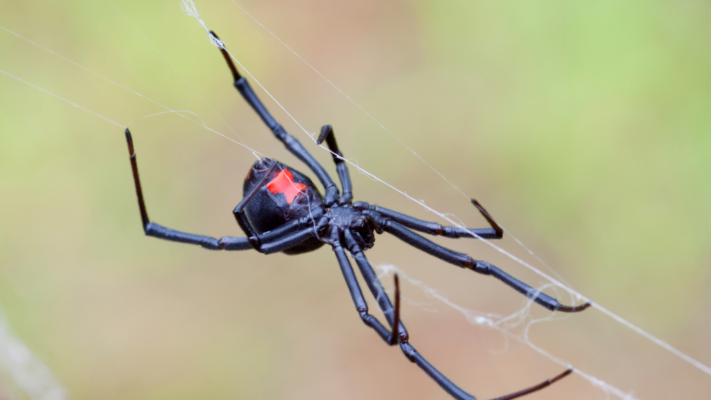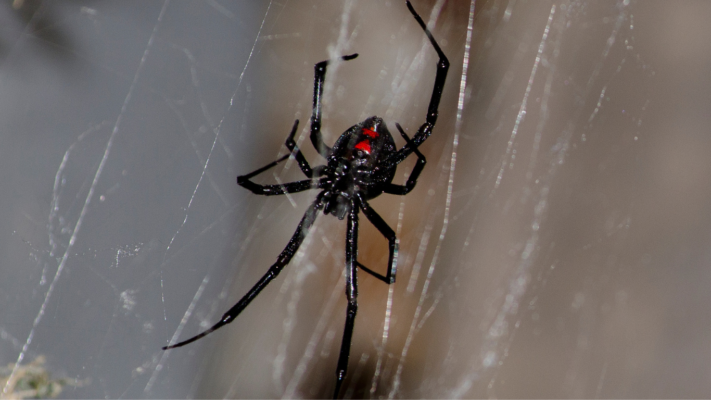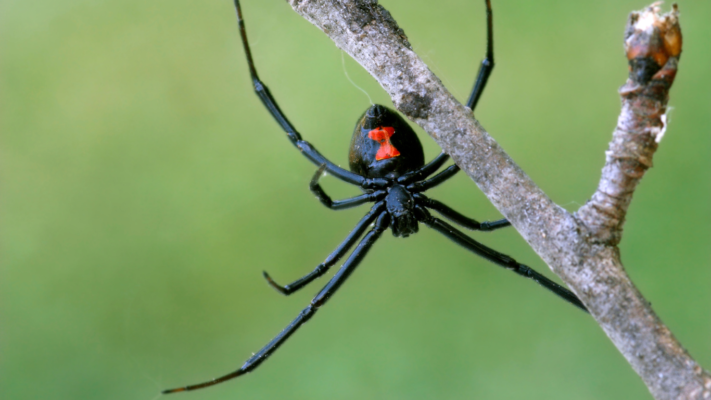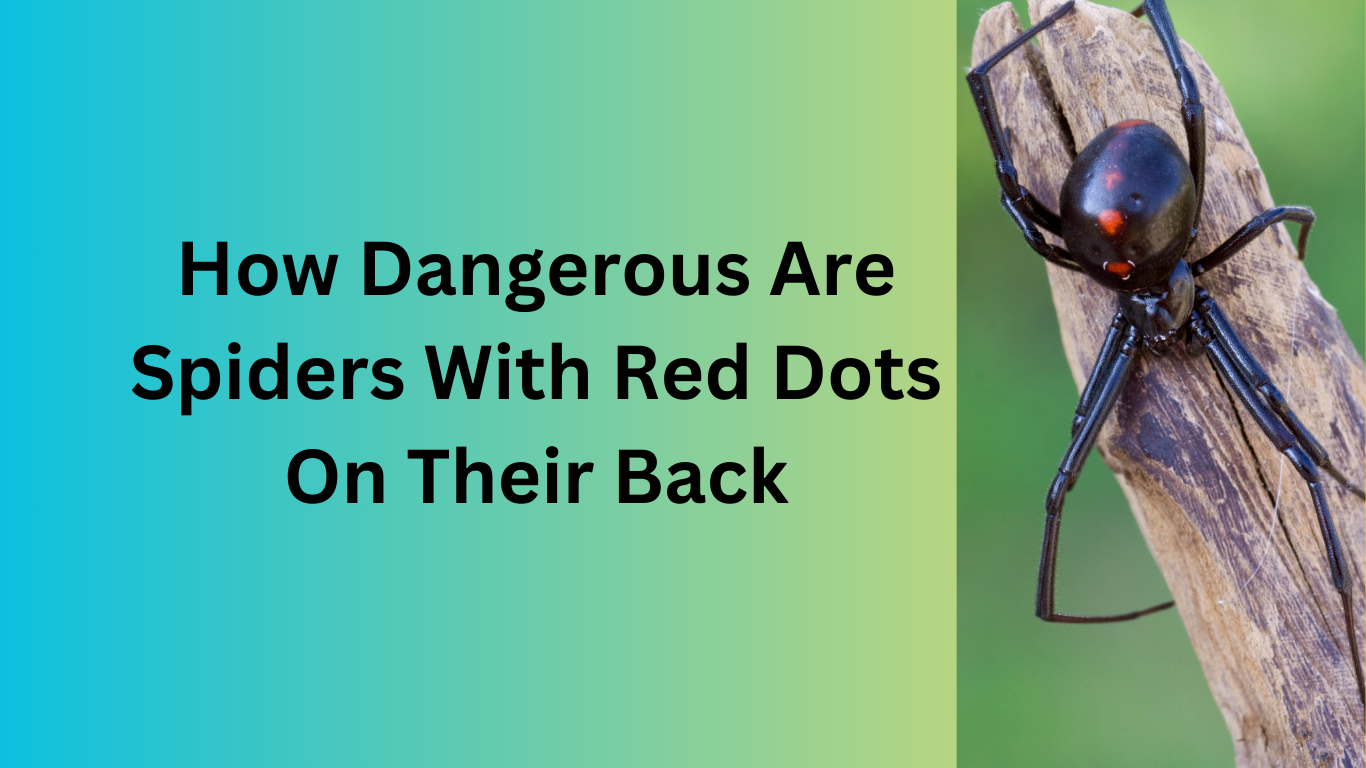The presence of red dots on the back of a spider often triggers apprehension and concern among individuals, leading them to wonder just how dangerous these arachnids might be. While it is true that some spiders with red markings can pose risks to humans, it is equally important to recognize that not all red-marked spiders are venomous or harmful.
In this article, we will navigate the nuances of these spiders’ potential hazards, dispelling myths and providing essential insights for understanding their true level of danger.
Importance of understanding the danger posed by spiders with red dots on their back
For several reasons, understanding the danger posed by spiders with red dots on their back is important. While not all spiders with red markings are necessarily dangerous, some can indeed be venomous and potentially harmful to humans. Here are some key reasons why it’s crucial to comprehend the risks associated with these spiders:
![]() Personal Safety: The most immediate and obvious reason is personal safety. Identifying and understanding the potential dangers associated with spiders with red dots can help individuals take appropriate precautions when encountering them. This knowledge can reduce the risk of accidental bites and subsequent health complications.
Personal Safety: The most immediate and obvious reason is personal safety. Identifying and understanding the potential dangers associated with spiders with red dots can help individuals take appropriate precautions when encountering them. This knowledge can reduce the risk of accidental bites and subsequent health complications.
![]() Health Risks: Venomous spiders may have red markings on their backs and can deliver toxic bites that lead to various health issues. Understanding these risks allows individuals to recognize the symptoms of a spider bite and seek prompt medical attention when necessary. Early treatment can prevent or mitigate serious health problems.
Health Risks: Venomous spiders may have red markings on their backs and can deliver toxic bites that lead to various health issues. Understanding these risks allows individuals to recognize the symptoms of a spider bite and seek prompt medical attention when necessary. Early treatment can prevent or mitigate serious health problems.
![]() Education and Awareness: Promoting awareness about dangerous spiders with red markings can help people make informed decisions. It includes knowing how to react when they encounter such spiders and dispelling myths and misconceptions that can lead to unnecessary fear or panic.
Education and Awareness: Promoting awareness about dangerous spiders with red markings can help people make informed decisions. It includes knowing how to react when they encounter such spiders and dispelling myths and misconceptions that can lead to unnecessary fear or panic.
![]() Wildlife Conservation: Understanding the dangers of certain spiders can also be necessary for wildlife conservation efforts. Sometimes, spiders with red markings are falsely identified as dangerous and killed unnecessarily. Educating the public about which species are truly dangerous can aid in preserving local ecosystems and biodiversity.
Wildlife Conservation: Understanding the dangers of certain spiders can also be necessary for wildlife conservation efforts. Sometimes, spiders with red markings are falsely identified as dangerous and killed unnecessarily. Educating the public about which species are truly dangerous can aid in preserving local ecosystems and biodiversity.
![]() Peace of Mind: Knowledge about the potential dangers of spiders with red dots can provide peace of mind, especially for individuals who live in areas where these spiders are prevalent. By knowing what to expect and how to respond, people can go about their daily lives with less fear and anxiety.
Peace of Mind: Knowledge about the potential dangers of spiders with red dots can provide peace of mind, especially for individuals who live in areas where these spiders are prevalent. By knowing what to expect and how to respond, people can go about their daily lives with less fear and anxiety.
![]() Emergency Preparedness: In regions where venomous spiders are common, such knowledge can be crucial for emergency responders and healthcare professionals. They need to be aware of the local species and the specific medical treatments required for spider bites to provide effective care.
Emergency Preparedness: In regions where venomous spiders are common, such knowledge can be crucial for emergency responders and healthcare professionals. They need to be aware of the local species and the specific medical treatments required for spider bites to provide effective care.
![]() Scientific Research: Understanding the venom and behavior of spiders with red markings is important for scientific research. It can contribute to advancements in antivenom development, the study of venomous creatures, and our understanding of ecosystems.
Scientific Research: Understanding the venom and behavior of spiders with red markings is important for scientific research. It can contribute to advancements in antivenom development, the study of venomous creatures, and our understanding of ecosystems.
![]() Community Safety: Knowledge about dangerous spiders is vital for the overall safety of communities. Local authorities and pest control professionals can use this information to implement control measures or offer guidance to residents when necessary.
Community Safety: Knowledge about dangerous spiders is vital for the overall safety of communities. Local authorities and pest control professionals can use this information to implement control measures or offer guidance to residents when necessary.
Danger Caused by Spiders With Red Dots on Their Backs

Spiders often have eye-catching red spots, stripes, or patterns on their bodies. Interestingly, these vibrant colors can serve as a form of deception. Many creatures, including some spiders, use these colors to trick potential predators into thinking they are toxic or dangerous. Spiders employ similar tactics.
Instead of solely relying on these markings, spider enthusiasts and experts distinguish between different spider species by carefully analyzing the arrangement of their eye structures.
In North America, the black widow spider holds the reputation for being the most dangerous. These spiders possess venom containing a potent ingredient called alpha-latrotoxin, which is approximately 15 times more powerful than rattlesnake venom. This toxin overwhelms nerve cells, resulting in excruciating pain for those unfortunate enough to be bitten.
If bitten by a black widow spider, the affected area can become incredibly swollen. Alongside this swelling, individuals may experience stomachaches, muscular spasms, and cramps. These symptoms can worsen for up to 12 hours after the bite, but then they should gradually subside.
Dangerous Effects of Spider Bites
Symptoms of Spider Bites:
Spider bites can vary widely in terms of symptoms, depending on the spider species, the individual’s sensitivity to the venom, and the location of the bite. Here are some common symptoms associated with spider bites:
![]() Pain and Swelling: One of the most immediate and common symptoms of a spider bite is localized pain and swelling at the site of the bite. The severity of the pain can range from mild to intense.
Pain and Swelling: One of the most immediate and common symptoms of a spider bite is localized pain and swelling at the site of the bite. The severity of the pain can range from mild to intense.
![]() Redness and Itching: The area around the bite may become red, and itching or irritation can occur.
Redness and Itching: The area around the bite may become red, and itching or irritation can occur.
![]() Two Puncture Marks: In some cases, especially when bitten by spiders with fangs large enough to pierce human skin, you may see two small puncture marks at the site of the bite. These marks can be a clue that a spider is responsible.
Two Puncture Marks: In some cases, especially when bitten by spiders with fangs large enough to pierce human skin, you may see two small puncture marks at the site of the bite. These marks can be a clue that a spider is responsible.
![]() Blister Formation: Blisters can develop at the site of the bite, and they may fill with fluid. It is more common with certain spider bites, such as those from brown recluse spiders.
Blister Formation: Blisters can develop at the site of the bite, and they may fill with fluid. It is more common with certain spider bites, such as those from brown recluse spiders.
![]() Systemic Symptoms: In some cases, especially with venomous spiders, the symptoms can become systemic, affecting the entire body. These symptoms may include:
Systemic Symptoms: In some cases, especially with venomous spiders, the symptoms can become systemic, affecting the entire body. These symptoms may include:
- Fever and chills
- Nausea and vomiting
- Muscle cramps and spasms
- Headaches
- Sweating
- Rapid heart rate
- Difficulty breathing
![]() Open Sores or Ulcers: Some spider bites, like those from brown recluse or hobo spiders, can develop open sores or necrotic ulcers at the site of the bite.
Open Sores or Ulcers: Some spider bites, like those from brown recluse or hobo spiders, can develop open sores or necrotic ulcers at the site of the bite.
Health Risks Associated with Venomous Spider Bites:
Venomous spider bites, while relatively rare, can pose significant health risks, and the consequences can vary depending on the species of spider involved. Here are some health risks associated with venomous spider bites:
- Black Widow Spider (Latrodectus spp.):
- The venom of black widow spiders contains neurotoxins that can lead to severe pain, muscle cramps, and abdominal discomfort.
- In rare cases, black widow bites can cause more severe symptoms, such as difficulty breathing, chest pain, and high blood pressure.
- Brown Recluse Spider (Loxosceles spp.):
- Bites from brown recluse spiders can result in necrotic skin lesions or ulcers that can be slow to heal.
- Systemic symptoms such as fever, chills, and nausea may also occur in some cases.
- Redback Spider (Latrodectus hasselti):
- Redback spider bites can cause symptoms similar to those of black widow bites, including intense pain, muscle stiffness, and systemic effects like nausea and vomiting.
- Hobo Spider (Tegenaria agrestis):
- While previously thought to be highly dangerous, recent research suggests that hobo spider bites are less severe than originally believed. Symptoms can include localized pain, redness, and swelling.
It’s important to note that the severity of symptoms and health risks can vary from person to person. While some individuals may experience mild reactions to spider bites, others may have more severe or allergic responses. If someone suspects they have been bitten by a venomous spider or experiences concerning symptoms, they should seek medical attention promptly.
Medical professionals can provide appropriate treatment to manage symptoms and prevent complications. Additionally, proper identification of the spider responsible for the bite can aid in determining the appropriate course of medical care.
Preventive Measures

How to Avoid Encounters with Dangerous Spiders:
Preventing encounters with dangerous spiders is essential for personal safety. While it’s impossible to completely eliminate the risk of encountering spiders, especially in natural environments, there are steps you can take to minimize the chances of coming into contact with them:
- Keep Indoor Spaces Clean:
- Regularly clean and declutter your home, including basements, attics, and storage areas. Spiders often thrive in dark and cluttered spaces.
- Seal Entry Points:
- Seal cracks, gaps, and openings in windows, doors, walls, and foundations to prevent spiders from entering your home.
- Remove Outdoor Debris:
- Clear debris, woodpiles, leaves, and other organic material from around the perimeter of your home. Spiders often hide in such areas.
- Maintain Landscaping:
- Trim bushes, shrubs, and trees near your home to reduce hiding places for spiders and their prey.
- Use Screens and Vent Covers:
- Install screens on doors and windows to keep spiders and insects out. Consider using vent covers to block entry points in attics and crawl spaces.
- Shake Out Clothing and Bedding:
- Before putting on clothes or getting into your bed, shake out clothing and bedding to dislodge any spiders that may have taken shelter there.
- Shoes and Gloves:
- Check shoes, gloves, and outdoor gear before using them, especially if they’ve been stored in a garage or shed where spiders may hide.
- Be Cautious in Sheds and Garages: Exercise caution when entering sheds, garages, or other outdoor structures where spiders may be more common. Use a flashlight to inspect corners and hidden areas.
Safety Precautions and Protective Measures:
In addition to avoiding encounters, taking safety precautions and using protective measures can further reduce the risk of spider bites and their potential consequences:
- Wear Protective Clothing:
- When working in areas where spiders may be present, such as gardens or wooded areas, wear long-sleeved shirts, long pants, gloves, and closed-toe shoes to minimize exposed skin.
- Use Insect Repellent:
- Apply insect repellent to exposed skin and clothing when spending time in spider-prone environments. Choose repellents that are effective against spiders.
- Inspect Bedding and Sleeping Areas:
- Before going to bed, inspect your bedding and sleeping area for any signs of spiders. Shake out pillows and blankets if they’ve been stored for a while.
- Educate Yourself:
- Learn about the common spider species in your region and their habitats to better understand where you might encounter them.
- First Aid Knowledge:
- Familiarize yourself with basic first aid for spider bites, such as cleaning the wound, applying a cold compress, and seeking medical attention if necessary.
- Identify Spider Bites:
- If you suspect a spider bite, try to identify the spider or take a photo of it (if safely possible) to aid in medical treatment.
- Medical Attention:
- Seek medical attention promptly if you experience severe symptoms after a spider bite, especially if you suspect it was from a venomous spider.
Remember that most spiders are not dangerous to humans, and they play important roles in controlling insect populations. It’s essential to strike a balance between protecting yourself and respecting the natural environment where spiders reside. When in doubt, consult with local experts or pest control professionals for guidance on managing spider-related concerns in your area.
Common Misconceptions about Spiders with Red Dots

![]() All Spiders with Red Dots Are Dangerous: One of the most widespread misconceptions is that any spider with red markings is inherently dangerous. In reality, many harmless spider species have red markings, and the presence of red coloration alone does not necessarily indicate venomous or harmful spiders.
All Spiders with Red Dots Are Dangerous: One of the most widespread misconceptions is that any spider with red markings is inherently dangerous. In reality, many harmless spider species have red markings, and the presence of red coloration alone does not necessarily indicate venomous or harmful spiders.
![]() All Red-Backed Spiders Are Venomous: There is a misconception that all spiders with a red back are venomous and pose a threat to humans. While some red-backed spiders, like the redback spider in Australia, are venomous, others are not. This generalization can lead to unnecessary fear.
All Red-Backed Spiders Are Venomous: There is a misconception that all spiders with a red back are venomous and pose a threat to humans. While some red-backed spiders, like the redback spider in Australia, are venomous, others are not. This generalization can lead to unnecessary fear.
![]() Every Red Dot Is a Widow Spider: Not all red dots or markings on spiders belong to widow spiders like the black widow or redback. Some other spider species, such as orb-weavers, may have red patterns that are completely unrelated to widow spiders.
Every Red Dot Is a Widow Spider: Not all red dots or markings on spiders belong to widow spiders like the black widow or redback. Some other spider species, such as orb-weavers, may have red patterns that are completely unrelated to widow spiders.
![]() Venomous Spiders Will Always Attack: Another misconception is the belief that venomous spiders are aggressive and will attack humans unprovoked. In reality, most spiders, even venomous ones, are more likely to retreat or bite only when they feel threatened.
Venomous Spiders Will Always Attack: Another misconception is the belief that venomous spiders are aggressive and will attack humans unprovoked. In reality, most spiders, even venomous ones, are more likely to retreat or bite only when they feel threatened.
Frequently Asked Questions:
Are all spiders with red dots on their backs dangerous?
No, not all spiders with red dots on their backs are dangerous. While some can be venomous and potentially harmful, many others are harmless to humans.
How can I tell if a spider with red markings is dangerous?
Identifying a spider’s species is crucial for assessing its danger level. Characteristics such as body shape, leg structure, and geographic location play key roles in identifying venomous species.
What are some common venomous spiders with red markings?
Some examples include the black widow spider (Latrodectus spp.) in North America and the redback spider (Latrodectus hasselti) in Australia. Both have red markings and are known for their venomous bites.
What should I do if I suspect I’ve been bitten by a spider with red markings?
Clean the bite area, apply a cold compress, and seek medical attention if you experience severe symptoms. Identifying the spider or providing a clear description can assist healthcare professionals.
Can spider bites from species with red dots be life-threatening?
While fatalities from spider bites are exceedingly rare, some species can cause severe symptoms that may require medical treatment. Prompt attention to symptoms is essential.
How can I prevent encounters with potentially dangerous spiders?
Keeping your living spaces clean, sealing entry points, and wearing protective clothing when working outdoors are effective measures to reduce the risk of spider encounters.
Are all red markings on spiders a form of warning or aposematism?
No, not all red markings are meant to serve as a warning. Some spiders use red coloration for other purposes, such as camouflage, mating displays, or prey attraction.
Is it safe to handle spiders with red dots on their backs?
Handling any spider without proper knowledge and precautions is not recommended. It’s best to observe them from a safe distance to avoid accidental bites.
Are there any specific regions where spiders with red markings are more common?
Yes, the prevalence of spiders with red markings can vary by geographic region. Some venomous species are more common in certain areas, so regional awareness is essential.
How hazardous are black widow spiders?
Black widow spiders (Latrodectus spp.) are considered some of the most hazardous spiders in North America due to their potent venom. While fatalities from black widow bites are extremely rare, their bites can cause severe symptoms, including intense pain, muscle cramps, and, in rare cases, more systemic effects. Medical attention is crucial if bitten.
When I see a black widow, should I be concerned?
It’s advisable to exercise caution when you encounter a black widow spider. While they are not aggressive and typically only bite when they feel threatened, their bites can be painful and may lead to complications in some cases. It’s best to avoid provoking or handling them.
How long do you have after getting bitten by a spider with red dots on its back?
The time frame for symptoms to appear after a spider bite can vary depending on the individual and the spider species. In some cases, symptoms may manifest within a few minutes, while in others, it may take longer. If you suspect a venomous spider has bitten you, seek medical attention promptly rather than waiting for symptoms to develop.
Do black widows chase you?
No, black widow spiders do not chase humans or other creatures. They are not aggressive and prefer to retreat rather than confront a perceived threat. Most spider bites occur when a spider feels cornered, trapped, or has direct contact with the spider—avoiding provocation and using caution when in areas where black widows may be present is the best approach to prevent bites.
Conclusion:
In conclusion, understanding the danger of spiders with red dots on their back is crucial for personal safety, dispelling myths, and promoting informed decision-making. While not all red-marked spiders are venomous, some, like the black widow, can deliver painful and potentially harmful bites.
By being aware of preventive measures, recognizing common misconceptions, and knowing how to respond to spider encounters, individuals can coexist safely with these arachnids and contribute to wildlife conservation efforts while maintaining peace of mind in spider-prone regions. Remember, most spiders, including those with red markings, prefer retreat over confrontation, making avoidance and respect for their natural habitats key to a harmonious coexistence.

